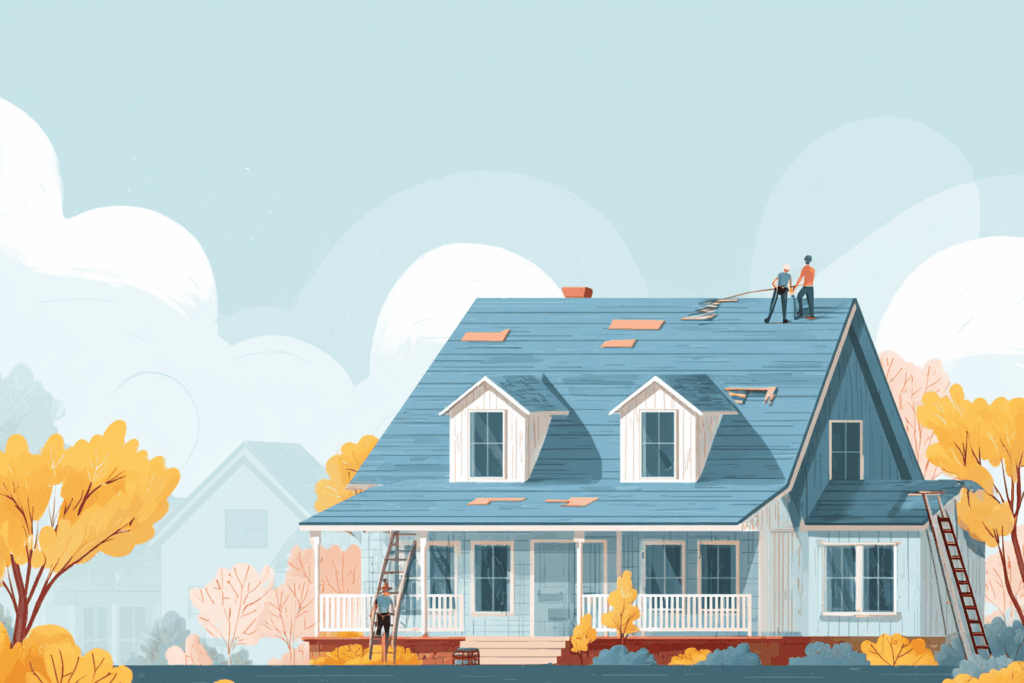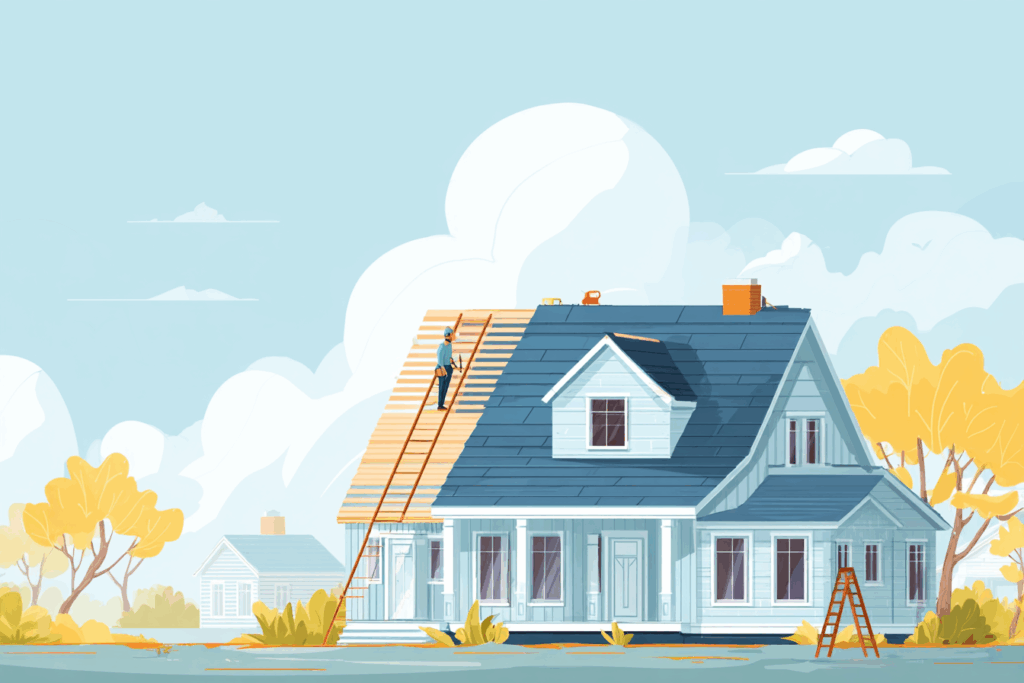Roof replacements and repairs are significant projects for any homeowner. Beyond the process of choosing shingles or picking a contractor, one of the most critical aspects is ensuring the work complies with building codes and standards.
Roofing regulations exist to keep your home safe, durable, and resilient against the elements. This guide will help U.S. homeowners understand why roofing codes matter, who sets them, key requirements to know, how codes vary by region, what the permitting and inspection process involves, and how to avoid the pitfalls of non-compliance. By navigating these regulations confidently, you can protect both your investment and your peace of mind.
Why Do Roofing Codes Exist (and Who Sets Them)?
Building codes – including roofing-specific codes – exist primarily to protect public health, safety, and welfare in construction. Without such codes, shoddy workmanship and unsafe structures could run rampant. Roofing codes ensure that your roof is built to withstand hazards like wind, fire, snow, and rain, keeping you and your family safe. They also promote uniform quality and durability standards across the industry.
In the United States, most residential roofing requirements are derived from the International Residential Code (IRC), a model code that outlines specific regulations for one- and two-family homes. The IRC covers everything from which materials are acceptable to minimum roof slope and even the nailing patterns for shingles. This model code is developed by the International Code Council (ICC), but it doesn’t automatically become law. Instead, state and local governments adopt the IRC (often with modifications) as their building code. In fact, the IRC (or a variation of it) is used in 49 states plus D.C., typically enforced by your city or county building department (often called the “authority having jurisdiction”).
Local municipalities can and do amend codes to address local conditions. For example, some cities might tweak requirements for roof snow loads or wildfire resistance based on their climate risks. Always remember: the model codes provide the baseline, but local building codes and ordinances are the final word. Before any roofing project, it’s wise to check with your local building department or the ICC’s online code listings to confirm which code edition and rules apply to your home.
Why all this complexity?
Simply put, roofing codes are there to ensure your new roof performs. A well-coded roof is more likely to survive a storm or fire. Studies even show that effective building codes have measurably reduced damage from hazards (for instance, better codes in Missouri led to a 10–20% reduction in hail damage). Ultimately, codes are the result of lessons learned – often after catastrophes – and they’re updated regularly to improve safety. Organizations like the ICC, along with state code councils and local officials, continuously refine these standards so that each new roof is safer than the last.
Key Aspects of Residential Roofing Codes

Roofing codes cover a wide range of details. Here are some of the key aspects U.S. homeowners should be aware of:
Materials and Fire Resistance
Roofing materials must meet fire safety standards. Materials are rated Class A, B, or C for fire resistance, with Class A being the most fire-resistant. Many jurisdictions require a Class A roof in residential areas, especially in wildfire-prone zones, to protect your home and neighbors. For example, California’s building code mandates Class A fire-rated roof assemblies in designated Fire Hazard Severity Zones. Common Class A materials include fiberglass asphalt shingles, concrete/clay tiles, slate, and certain metal or treated wood systems. Using approved, fire-rated materials is not just about code compliance – it’s about buying crucial time in a fire emergency.
Roof Slope and Drainage
Codes dictate suitable roof coverings based on slope (pitch). For instance, standard asphalt shingles are only allowed on roofs with a pitch of 2:12 or greater (2 inches of rise per 12 inches run). Low-slope roofs (between 2:12 and 4:12) can use shingles only if special double-layer underlayment techniques are applied to prevent leaks. If a roof is flatter than 2:12, different materials (like rolled roofing or membranes) must be used. These rules ensure water reliably runs off and doesn’t pond on the roof. Steeper roofs naturally shed water and snow more easily, while flat or low-slope roofs require carefully engineered drainage (like interior drains or scuppers in commercial buildings). When reroofing, altering the slope of your roof would also trigger structural code requirements and permits.
Wind Resistance and Fastening
Roofing codes account for windstorms and hurricanes. Roof assemblies (the shingles, underlayment, decking, fasteners, etc.) must resist uplift pressures for the design wind speed in your area. Along coastlines and tornado-prone regions, this is critical. The code will specify, for example, how many nails per shingle and what type of nail to use (often a minimum length and gauge) to ensure shingles stay put in high winds. In high-wind zones, local codes may go further – Florida, for instance, requires additional nailing patterns, stronger adhesives, and wind-rated shingles that can withstand winds of 150+ mph in some areas. Proper fastening is so important that using the wrong fastener or too few nails isn’t just a bad idea; it’s also illegal according to code and can cause a roof to fail in a storm. Always make sure your roofer follows the manufacturer’s installation instructions and local wind uplift requirements.
Snow Loads (Structural Strength)
In snowy regions, codes ensure roofs won’t collapse under heavy snow. Each region has specific snow load requirements, usually expressed in pounds per square foot (psf), based on historical snowfall data. For example, a Colorado mountain county might require a roof structure to handle 35 psf at 6,500 ft elevation, increasing to 45 psf at higher elevations. This means the rafters, trusses, and decking in those homes are beefed up accordingly. While this is more about the structural framing than the shingles, it’s all part of the roofing regulations.
Ventilation Requirements
A well-ventilated roof prolongs shingle life and prevents moisture problems in the attic. Building codes require enclosed attics to have ventilation openings (soffit vents, ridge vents, etc.) that allow fresh air in and out. The IRC generally calls for a net vent area equal to 1/150 of the attic area (or 1/300 in some cases where certain conditions are met). The vents must be distributed (high and low on the roof) and screened to keep out rain and pests.
Flashing and Waterproofing
Roofing codes pay special attention to flashing – the metal (or similar) pieces that seal joints and penetrations on the roof. Flashing must be installed at all roof penetrations and at transitions(around chimneys, skylights, where a roof meets a wall, in valleys, along eaves and rakes, etc.). The purpose is to channel water away from vulnerable areas. Reusing old flashing that is damaged or corroded is usually not allowed; for instance, the IRC prohibits reusing flashing that has been bent or punctured during removal.
Fire and Impact Ratings
As mentioned under materials, fire resistance is a key part of code compliance. Additionally, some local codes or insurance-driven standards encourage impact-resistant roofing in hail-prone areas (rated by UL 2218, for example). While the national model codes currently don’t mandate hail-resistant shingles, homeowners in places like Texas or Colorado often choose Class 3 or 4 impact-rated shingles for better performance in hailstorms.
How Roofing Codes Vary by Region (Florida vs. Colorado vs. California)
The United States spans many climate zones and hazard areas, so it’s no surprise that roofing codes vary widely by region. The core principles (from the IRC) might be the same, but local amendments tailor the rules to local needs:
Hurricane-Prone Areas (e.g., Florida and Coastal States)
In hurricane alley, wind is enemy number one for roofs. Florida has some of the strictest roofing codes in the country. The Florida Building Code (FBC), which is based on the I-Codes but with state-specific enhancements, requires roofs to meet high wind-speed ratings. For example, in Miami-Dade County (a High Velocity Hurricane Zone), a shingle or tile roof must be laboratory-tested and approved to withstand extreme uplift forces (often 150–180 mph gusts). Installation methods are beefed up: more nails per shingle, water-tight underlayments (Florida even mandates a secondary water barrier in some cases), and hurricane clips tying the roof structure to the walls.
There’s also a unique “25% rule” in Florida: if more than 25% of your roof is damaged and being repaired within 12 months, you’re generally required to replace the entire roof and bring it up to current code. This is aimed at preventing patchwork fixes in hurricane country – a patch won’t perform like a whole new code-compliant roof, so the law says “replace it all” for safety.
Snow Country (e.g., Colorado, Northern US)
Regions with heavy snowfall have roofing codes focused on structural loads and ice damage prevention. As noted, Colorado’s mountain communities assign specific snow load requirements by elevation. A homeowner in Denver (mile-high elevation) might have a code-mandated snow load of around 30 psf, whereas someone in a ski town at 9,000 ft could face 100+ psf requirements. This means your rafters/trusses, connections, and roof decking must be engineered accordingly – typically handled by your original home design, but if you alter the roof structure, it must be re-approved by engineers/inspectors.
Snowy climate codes also often require an ice dam membrane (ice and water shield) along the eaves of shingled roofs to prevent leaks in case ice backs up under shingles. Moreover, cold climates stress attic ventilation (to keep the roof cold and prevent ice dams) and adequate insulation. Colorado and the High Plains also get large hail; while, as mentioned, model codes don’t yet mandate hail-proof shingles, many homeowners opt for them, and some insurance companies or local ordinances encourage it. In short, the code in a place like Colorado ensures your roof can bear the snow load in January and the hail impacts in June – very different challenges than Florida’s, and the rules reflect that.
Wildfire Zones (e.g., California and the West)
In fire-prone areas, roofing codes zero in on fire resistance. California’s building code requires Class A fire-rated roofs in designated wildfire zones to resist wind-blown embers and flames. Wood shake or shingle roofs, which might be allowed elsewhere, are largely prohibited or require special fire-retardant treatment in these areas. California also has Wildland-Urban Interface (WUI) codes that go beyond the roof covering: they require things like ember-resistant attic vents, sealed eaves, and cleared vegetation, which aren’t “roofing codes” per se but are related measures to improve a roof’s chance of surviving a wildfire. Additionally, California’s climate policies include energy efficiency standards; for instance, the state energy code (Title 24) may require “cool roof” materials (roofing with high solar reflectance) on new construction or major reroofs in certain hot climate zones to reduce cooling energy use. So, a homeowner in Los Angeles replacing a roof might find that the code not only asks for a Class A fire-rated shingle but also one that is a certified cool roof product. Meanwhile, seismic concerns in California mean the roof structure must be well anchored. However, earthquakes don’t usually destroy roofs independently; the connections (like nailing the roof sheathing and strapping rafters to the walls) are inspected carefully as part of the overall structural integrity.
Other Regional Tweaks
Every region has its quirks. The Pacific Northwest worries about moss and rain, so underlayment and flashing rules are key. The Desert Southwest faces intense sun and thermal expansion issues – local practices might favor materials that handle heat better (tile, metal), and code may emphasize ventilation and insulation to combat attic heat. High-altitude areas require considering high winds (even outside of hurricanes, mountaintop homes can see powerful gusts). Coastal New England might incorporate both heavy snow loads and high wind from nor’easters. The golden rule is to check your local code: what flies in one state may be forbidden in another. For instance, a skylight that isn’t impact-rated is fine in Illinois, but against code in coastal Florida due to hurricane projectile risks. A roof overlay (installing new shingles over old) might be allowed in Kansas, but not allowed in a hail-prone Colorado county or a hurricane zone in Texas – because those areas insist on inspection of the deck and nailing during replacement. Always work with a contractor who knows the local amendments inside out.
The Roofing Permitting Process and Inspections
Even the best code in the books means little if it’s not enforced. That’s where permits and inspections come in. Homeowners should view the permitting process not as red tape, but as a safeguard that ensures you’re getting a safe, legal roof.
When is a permit required?
Generally, for any significant roofing work – especially a full roof replacement – a building permit is required from your city or county. Minor repairs (fixing a few shingles, for example) may not trigger a permit in many jurisdictions, but replacing a large section or the whole roof certainly will. As a rule of thumb, if you’re replacing an entire roof covering (shingles, underlayment, etc.), you need a permit. Many areas set specific thresholds; for example, in Denver, any repair exceeding 10% of the roof area or more than 200 square feet requires a permit. Always check your local threshold; err on the side of caution and ask the building department if you’re uncertain.
How to get a permit
If you’ve hired a roofing contractor, they will usually handle the permit application on your behalf (and the permit is typically issued in the contractor’s name or their company’s). Make sure your contractor is doing this – unpermitted work is a big risk (more on that in the next section). The permit process involves submitting a simple application describing the project; for a roof, you might need to note the type of roofing material, the area, and whether any structural changes are involved. In some cases (especially if you’re changing the roof’s structure or in a historic district or high-wind area), you might have to submit more detailed plans or engineering specs for approval. Usually, though, a standard reroof permit is pretty straightforward and quick to obtain. There will be a fee, typically on the order of tens or a few hundred dollars, depending on your locale. Once fees are paid and any plan check is done, you’ll get the physical permit or an online permit card that must be posted at the job site.
Why bother with permits?
A permit ensures that a certified inspector will verify that the work is done to code. The purpose of a permit (and associated inspections) is to catch mistakes or unsafe shortcuts before they become your problem. As one roofing company put it: the permit tells the county that you’re making changes, and “the purpose of a permit is to ensure that the work is done safely and in compliance with local building codes and regulations.” If you skip the permit, there’s no official oversight that your roofer did things right.
Inspections
After the permit is issued, the work can begin. Roofing jobs may have multiple inspections. Some jurisdictions require an in-progress inspection (for example, a nailing inspection before the new shingles go on, so the inspector can see that the decking and underlayment are proper and the nailing pattern meets code). In other areas, only a final inspection is done after the roof is completed. At the very least, expect a final inspection: an inspector will come check that the new roof complies with codes and the manufacturer’s installation instructions. They’ll look at things like: Are the shingles installed flat and secured? Is the flashing new and correctly placed? Is there a drip edge along the eaves? Are the roof vents in place and sufficient? Does everything look properly sealed and safe? If the roof has any complicated bits (chimneys, skylights, a flat section, etc.), they’ll pay attention to those. If any aspect doesn’t pass muster, you’ll be notified that it needs correction, and typically, a re-inspection will be scheduled after fixes are made. It’s worth noting that inspectors are not there to nitpick aesthetics – they focus on safety and code items. For example, they’ll care that your chimney flashing isn’t leaking, but they won’t care about a cosmetic shingle color issue.
Once you pass the final inspection, the permit will be signed off or closed, and your roof will be officially code-compliant. Keep that final approval for your records! It’s valuable when selling the house or making an insurance claim to show the roof was permitted and approved. Pro tip: If you’re hiring contractors, final payment is often best tied to passing inspection – reputable roofers agree that the job isn’t truly “done” until the city inspector signs off that it’s done right.
Tips for Homeowners to Ensure Roofing Code Compliance
Staying on top of roofing codes might sound daunting, but these practical steps will help any homeowner navigate the process smoothly:
- Hire a Licensed, Knowledgeable Contractor: This is your first line of defense. Licensed roofers are required to know and follow roofing codes, and they risk losing their license and hefty fines if they don’t. A reputable contractor will obtain all necessary permits, utilize code-approved materials, and ensure the installation complies with local standards. Don’t be shy about asking a contractor, “Will this project be pulled under a permit and inspected?” The answer should be yes for anything beyond a very minor repair.
- Do Some Homework on Local Codes: While you’re not expected to memorize the IRC, it helps to be generally aware of what your local roofing codes entail. Many city building departments publish homeowner-friendly guides. For example, some will list if an ice shield is required or what the ventilation rules are. Knowing these tidbits can help you discuss the project intelligently with your roofer. At minimum, know what code edition your area is under (e.g., “2018 IRC with local amendments”).
- Plan for Your Region’s Needs: Ensure your contractor plans for any special regional requirements. Are you in a high-wind area? Make sure the shingles and attachment method are rated for it (e.g., in a hurricane zone, insist on wind-rated shingles and ask if extra nailing or ring-shank nails will be used). In wildfire country, confirm that all roofing materials are Class A and that details like metal drip edge (which can help in fire spread prevention) are included. Cold climate? Verify they’ll install the ice dam protection membrane and adequate vents.
- Obtain and Keep All Documentation: When the contractor pulls the permit, ask for a copy of it. After final inspection, obtain a copy of the signed inspection card or approval record. Also, keep copies of material warranties and the contract scope of work.
- Stay Updated and Communicate: Roofing codes can change with each code cycle (usually every 3 years when the IRC is updated). Significant events can also prompt local code changes (for example, a severe hurricane might lead a city to strengthen requirements).
- Don’t Cut Corners to Save Small Change: It might be tempting if a contractor says, “We could save a few hundred dollars by not pulling a permit, and no one will know.” Don’t do it. The small upfront cost of compliance is nothing compared to the potential costs of non-compliance (fines, redoing work, or worse).
Consequences of Non-Compliance
What if roofing work is done without regard to codes and permits? Unfortunately, the risks are significant and multifaceted:
- Failed Inspections and Rework: If you forgo a permit and your city finds out (say, a neighbor complains or an unrelated inspector spots it), you could get a stop-work order. You’ll then have to obtain a permit and possibly expose (or even tear off) completed work so it can be inspected. If the work doesn’t meet code, you may be required to redo it at your own expense – effectively paying for your roof twice.
- Fines and Legal Penalties: Doing a roof without a required permit is a violation of local law. Many jurisdictions impose fines, which can range from a few hundred dollars to thousands, often depending on the duration of the uncorrected violation. In some cases, municipalities charge a multiple of the permit fee as a penalty (for example, six times the normal permit fee). Severe or willful violations could even involve court citations. A
- Insurance Risks: Homeowners insurance typically requires that your home comply with local codes. If you have unpermitted or non-code-compliant roofing work, and later you have a loss (say a windstorm rips off part of the roof or causes water damage), an insurance adjuster may investigate. Insurance companies can deny claims if the damage resulted from work that was not permitted or not up to code.
- Void Warranties: Most roofing material manufacturers state that their warranty is void if the roof is not installed according to code or their instructions. If an improperly installed or non-code roof fails, the shingle manufacturer won’t honor the warranty – leaving you without that safety net.
- Reduced Home Value & Sale Complications: When you go to sell your home, any knowledgeable buyer (or their home inspector) can spot a new roof and will ask, “Was this done with a permit?” If you can’t produce a permit and final inspection approval, it raises red flags. Buyers may back out or insist you go through a belated permitting process (called legalization, which can mean opening up portions of the roof to prove it’s done right). Unpermitted work can also delay or derail a sale, and at the very least, it can reduce your home’s appraised value.
- Safety and Performance Issues: Finally, the most important consequence: your roof might simply not perform when it needs to. Codes exist because of real-world failures. If a roof isn’t up to par, you might not notice on a calm sunny day, but you will notice in a blizzard, a hurricane or a wildfire ember shower. A non-code-compliant roof could leak, blow off, collapse, or even contribute to a fire spreading. These are life-safety issues.
Conclusion
Navigating roofing regulations and building codes may seem complex, but it boils down to this: build it right, build it safe, and follow the rules that experts have put in place to protect us.
For U.S. homeowners, that means using quality materials, hiring qualified professionals, pulling the necessary permits, and adhering to local building codes from start to finish. Yes, it requires some homework and diligence, but the reward is a roof you can trust over your head.
Remember, building codes are not arbitrary hoops to jump through; they’re the distilled wisdom of engineering and experience, written in ink. By following this guide and leveraging the cited resources, you can approach your next roofing project with confidence and ensure that your beautiful new roof is more than just skin-deep – it’s solidly compliant and built to last. Here’s to staying dry, safe, and stress-free under a code-compliant roof!
You might also be interested in: How to Make Your Roof More Energy Efficient




